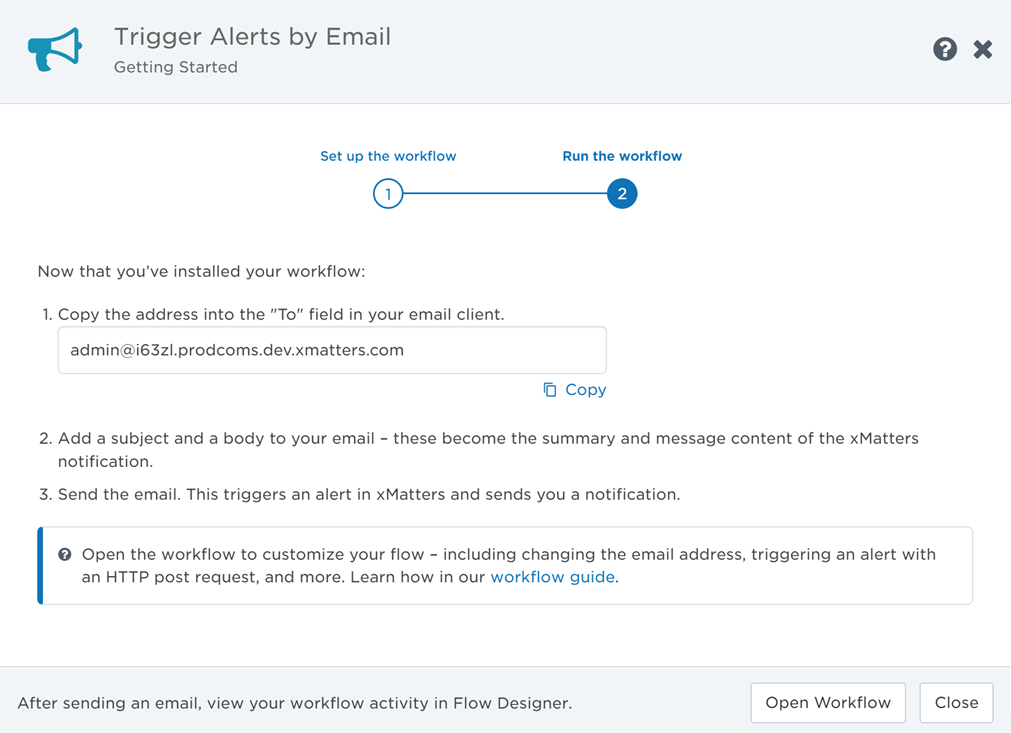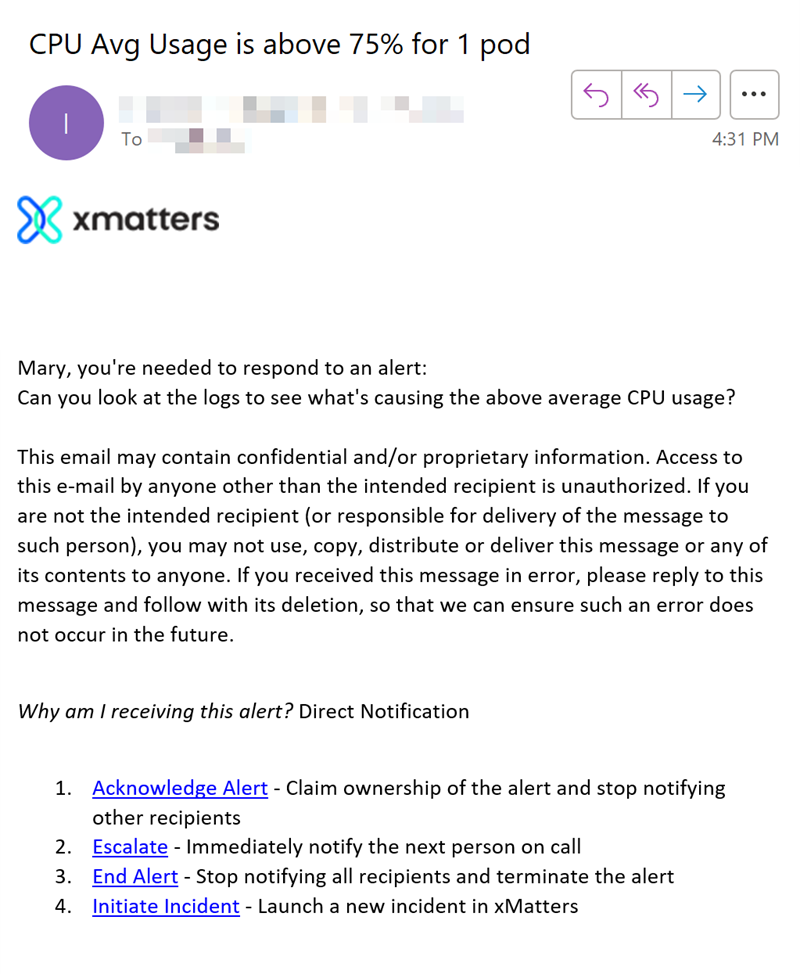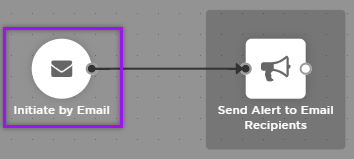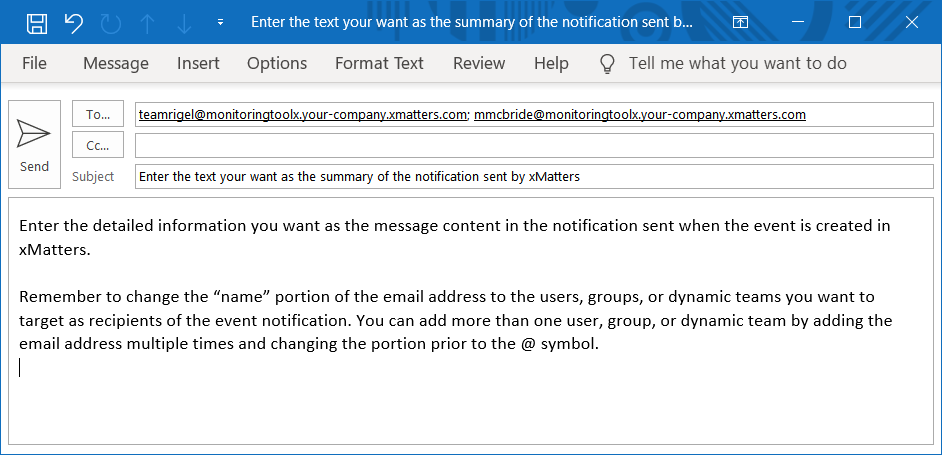Trigger Alerts by Email
The Trigger Alerts by Email workflow is a pre-built workflow template designed to help you start notifying users and groups with minimal setup. It lets you create an alert and send notifications by simply sending an email to xMatters.
Here are some ideas for using this workflow:
- Get your incident management team started with learning how to trigger a notification in xMatters.
- Use it as a jumping-off point for building out your own, fully customized workflow. Change a few labels, update some response choices, modify an endpoint and presto — you have a production-ready workflow that’s customized for you.
- Poke around inside and pick it apart to get an understanding of how workflows are built and how the pieces fit together.
- Use it as a handy reference when building your own workflow from scratch.
Install the workflow
- Go to the Workflows Templates page and click the Trigger Alerts by Email tile.
- On the Set up the workflow dialog, give the workflow a name that identifies its purpose (this must be unique in your instance), add an optional description, and set the default incident type (if applicable). Any built-in Initiate Incident steps in the workflow will automatically be set to the selected incident type.
- You can edit these later, if needed.
- Click Next to follow steps to test your workflow. To get started right away, simply send an email to the address listed in the dialog, changing the portion of the email address before the '@' to the user, group, service, or dynamic team you want to notify. For example, to send notifications to 'RigelServiceTeam', change your username to 'RigelServiceTeam'.
- Click Open Workflow to start using the workflow, or if you want to customize the workflow settings.


The Trigger Alerts by Email notification
Here's an example of the default notification:

The notification provides the recipient with the following response choices:
- Acknowledge Alert - Claim ownership of the alert and stop notifying other recipients.
- Escalate - Immediately notify the next person on call.
- End Alert - Stop notifying all recipients and terminate the alert.
- Initiate Incident - Launch a new incident in xMatters.
Using the workflow
You can start initiating alerts with the Trigger Alerts by Email workflow right away, or you can first customize the email trigger to change the recipient of the alert.
When you install the workflow, you can send an email from any email address to the email address given in the next steps. When you compose the email, you can change the portion of the email address before the '@' to the target name of the recipient you want to notify. For example, to send notifications to the group 'RigelServiceTeam', change your username to 'RigelServiceTeam'. You can also set the email trigger to only accept emails from an address associated with an user in xMatters.
To customize the email trigger:
- On the Flow Designer tab of your workflow, click the Trigger Alerts by Email canvas.
- In the canvas, double-click the Initiate by Email trigger to open it (or hover over it and click the pencil icon).
- In the Authentication Method section of the Settings tab, select the authentication method to use to initiate the alert. You can configure the email trigger to either:
- Send from any email: Accept emails from any address. The flow and any connected steps are authenticated using the credentials of the authenticating user. This defaults to you, but you might want to change this to an integration user, if you've set one up.
- Send from an xMatters email device: Only accept emails from an address associated with a device in xMatters. The flow and any connected steps are authenticated using the permissions of the user the sender's email address belongs to.

Optional setup changes
There are some optional changes you can make to the email trigger to better reflect the purpose of your workflow:
- Trigger Label: You can modify the label of the step by opening the trigger on the canvas and clicking on its name. This could be useful to differentiate between multiple email triggers if you plan to add more onto the canvas.
- Trigger ID: The trigger ID is the portion of the email address after the '@' symbol. By default, it is a randomly assigned sequence of letters and numbers, but you can customize it to help email senders easily see what incident or workflow the email relates to. For example, you can rename the trigger ID to 'generic-alert' or 'monitoringtoolname'.
For more information on configuring the email trigger, see Email Initiation trigger.
To send a notification using the Trigger Alerts by Email workflow:
- On the Flow Designer tab of your workflow, click the Trigger Alerts by Email canvas.
- In the canvas, double-click the Initiate by Email trigger to open it (or hover over it and click the pencil icon).
- In the Email Address section of the Settings tab, click Test Email to open your email client with the address in the 'To' field automatically filled out. You can also click Copy Address to copy it to your clipboard.
- In your email client, fill in the following fields:
- To: To send the alert to specific users or groups, replace your user ID (the portion of the email address before the '@' symbol) with the name of the user, group, service, or dynamic team you want to target. If you want include more than one targeted recipient, add multiples of the address into the 'To' field with different target names.
- Subject: This serves as the summary and title of the xMatters alert.
- Body: The email content makes up the alert message.

- Send the email, and then open the Activity panel to monitor the progress of your flow.

Do more
The Trigger Alerts by Email workflow gets you creating alerts and sending notifications quickly. There's a lot more you can do if you want to. Here are some ideas:
- Change the message content or layout: The notification sent to users includes a summary and a detailed message (for example, the subject and the body of an email). You can change this by editing the message design.
- Change the response options: You can add or remove response options, or change what happens when a recipient selects a particular response.
- Add additional steps to the flow: Use Flow Designer to visually build flows that connect your tools and processes simply by dragging and dropping steps onto a canvas.
